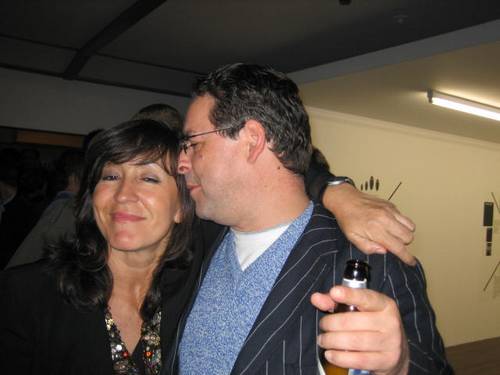SWEDISH DISH PUBLISHED IN "SCENE AND HERD" SECTION

The galleries at this see-and-be-seen event were packed to the point that one worried about the art; it's a wonder that Rivane Neuenschwander's installation of dripping, water-filled buckets, Chove Chuva, 2002, survived the back-to-school crush. Other artworks in the show include Tobias Rehberger's 222 colorful glass lamps, Seven Ends of the World, 2003, which was originally exhibited in the Birnbaum-cocurated Italian Pavilion at that year's Venice Biennale; its suspended orbs function as a big, complicated solar clock. Slightly more site-specific is Olafur Eliasson's proposal for a new Stockholm art museum, the design of which is based on the varying angles of sunlight throughout a year in the city. Also fitting neatly into the sun theme were Tacita Dean's films about solar eclipses, Banewl (1999) and Diamond Ring (2002).
Left: Former IASPIS director Karina Ericsson Wärn and currect director Maria Lind. Right: Gallery owner Natalia Goldin and artist Allen Gubresic.
According to Magasin 3 director David Neuman, cooperating with four associate curators is the starting point of a new path for the institution. Neuman's vision seems to revolve around using brainpower to "push boundaries," both literal and metaphorical. Norrköpings Museum of Art curator Marianne Hultman, for one, wasn't impressed, commenting on the namby-pamby nature of the exhibition by rhetorically asking, "How come no matter what artists or curators you put into Magasin 3, the results always look the same? Neat, tidy, stiff, and a bit boring." Perhaps this is what consensus among four opinionated curators looks like. Out on the balcony, the chain-smoking Sans came to the show's defense, stating that it is a very "poetic" show. In my own opinion, it's a shame that "Here Comes the Sun" doesn't include more brand-new work, though it was good to see an ambitious exhibition of biennial-circuit artists in Stockholm.
Two hundred guests wined (less conservatively) and dined afterwards in the Magasin 3 project space. Among them were the newly bearded Swedish Minister of Culture, Leif Pagrotsky; Moscow Biennial curator Joseph Backstein; Udo Kittelmann, the director of the MMK in Frankfurt; Lars Nittve, the director of the Moderna Museet; dealers Burkhard Riemschneider and Ciléne Andréhn; and artists Carsten Höller and Miriam Bäckström, all wolfing down a traditional Swedish feast of crayfish and vodka. To my disappointment and despite the best efforts of the DJ, the inebriated crowd never made it to the dance floor; people seemed more interested in chatting and huddling up by the bar. At some point artist Juan Pedro Fabra Guemberena painted a "tattoo," apparently titled Ass on Fire, directly onto my arm and two other artists (who, at their entreaties, shall remain anonymous) decided to decorate the tablecloth with other unmentionables. The next day was dubbed "Aspirin Day" by widespread consent. The season had officially begun.
